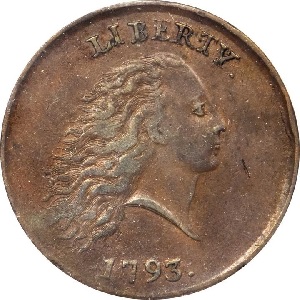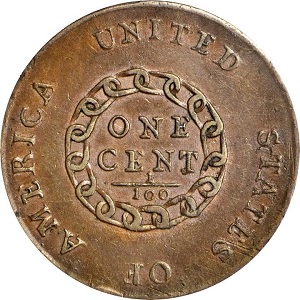1793 Flowing Hair Cent, Chain Rev, AMERICA, Periods
The Mint Act of April 2, 1792 established the United States Mint and the regulation of coinage for the newly formed republic. Construction of the coining facility, the first federal buildings built under the auspices of the Constitution, commenced on July 19, 1792. By year’s end, “Ye Olde Mint” was in business, striking a limited number of pattern coins.(1)
The 1793 Flowing Hair Chain Reverse cents were the very first general issue coins struck by the United States. A total of 36,103 Chain cents were delivered to the Mint’s treasurer between March 1 and March 12 of that year. From there, the new coins were released to the American public.(2)
There are three major varieties, or types, of Chain cents. The first of these featured the “AMERI.” reverse. Instead of spelling out “America” fully, the engraver omitted the last two letters.
Next came a new reverse with “AMERICA” written in its entirety.
The final type used the same “AMERICA” reverse, but with two periods on the obverse, one after the word LIBERTY and the other following the 1793 date.(3) The 1793 Chain cent "With Periods" is the focus of this page and the charts below.
Centuries ago, when coin dies were manually crafted, small variations between dies of the same design were observable. Thus, every die was unique and identifiable. For the Chain cents, four obverse dies were “married” with two reverses to produce their mintage.(4)
Any specific marriage of an obverse and reverse die begets a “die variety” (not to be confused with a major variety). It is important to understand the five Chain cent die varieties:
| Obverse ID | Reverse ID | Die Variety ID |
|---|---|---|
| A (No Periods) | A (AMERI.) | S-1 |
| A (No Periods) | B (AMERICA) | S-2 |
| B (No Periods) | B (AMERICA) | S-3 |
| C (No Periods) | B (AMERICA) | NC-1 |
| D (Periods) | B (AMERICA) | S-4 |
Chief Coiner Henry Voigt is generally credited (or blamed) with engraving the Chain cent dies, although some researchers suggest the obverse die for the S-4 (i.e., the one with periods) may have been the work of Joseph Wright, because Liberty’s hairstyle is not the same compared to the other varieties.(5)
Another bit of evidence bolstering this supposition is the periods are similar to Wright's 1792 pattern quarter, the only coin from that era where a period was used in this manner.(6)(7)
There are no specifics on how the Chain cent mintage of 36,103 was split up between the varieties. However, scholars have studied contemporary Mint records and pieced together other information to estimate a production of 8,800 pieces(8) for the S-4 "With Periods" variety, of which only about 325 remain today.(9)
All Chain cents, regardless of the type, are cherished by collectors of the 21st century. Because of their historic role as the first federal government coins to enter American society, they rank among the most famous United States coins of all time.
Currently, prices are a bit down from their record highs, indicating a temporary opportunity exists for bargain hunters.
| Estimated survivors in all grades: 325 ?
The survivor estimate from PCGS represents an average of one or more experts' opinions as to how many examples survive of a particular coin in all grades. Survival estimates include coins that are raw, certified by PCGS, and certified by other grading services. Learn more at PCGS. |
| PCGS Rarity Scale: 6.3 ?
The 'PCGS CoinFacts Rarity Scale' assesses the relative rarity of all U.S. coins, based on estimated surviving examples. The scale runs from 1.0 to 10.0. The higher the number, the rarer the coin.
Learn more at PCGS. |
| Click HERE to check for availability on eBay** |
Preview of eBay selection:
 |
 |
| Trendline Avg = 12.15 | CLASSIC RARITY |
Historic Value Trend Charts:
| Last updated 11-11-24 | Return to Key Date Coin List | |
| There are no Common Date comparisons for this coin. | ||
|
|
||
| Download Charts to Your Computer | ||
Sources
1. Taxay, Don. The U.S. Mint and Coinage. New York, NY: Sanford J. Durst Numismatic Publications, 1966.
2. Heritage Auctions. 1793 1C Chain, AMERICA, Periods, S-4. Jun 2018 Auction.
3. Stack's Bowers Galleries. 1793 Flowing Hair Cent. Chain Reverse. S-4. AMERICA, With Periods. Aug 2020 Auction.
4. Heritage Auctions. 1793 1C Chain, AMERICA, S-2. Jan 2018 Auction.
5. Heritage Auctions. 1793 1C Chain, AMERICA, Periods, S-4. Apr 2020 Auction.
6. Heritage Auctions. 1793 1C Chain, AMERICA, Periods, S-4. Jun 2018 Auction.
7. Stack's Bowers Galleries. 1793 S-4. Chain, AMERICA, Periods. Jul 2004 Auction.
8. Heritage Auctions. 1793 1C Chain, AMERICA, Periods, S-4. Apr 2020 Auction.
**Many very fine coin dealers sell on eBay. At any point in time, there may be over one million search results for United States coins. This includes quite a few of the recommendations on our Key Date Coin List.
If you’re thinking about purchasing a rare coin, eBay is certainly worth a look. For your convenience, the links from this site to eBay are coded to bring up only coins certified by PCGS and NGC.
As is always, always the case, never buy a valuable coin from a seller whose trustworthiness cannot be verified. Learn more about this at our chapter Best Places to Buy Coins, which also has a section on doing business on eBay.
In the interest of full disclosure, Rare Coins 101 receives a small commission anytime someone connects to eBay from this site and purchases something.
Coin images by Stack's Bowers Galleries.


